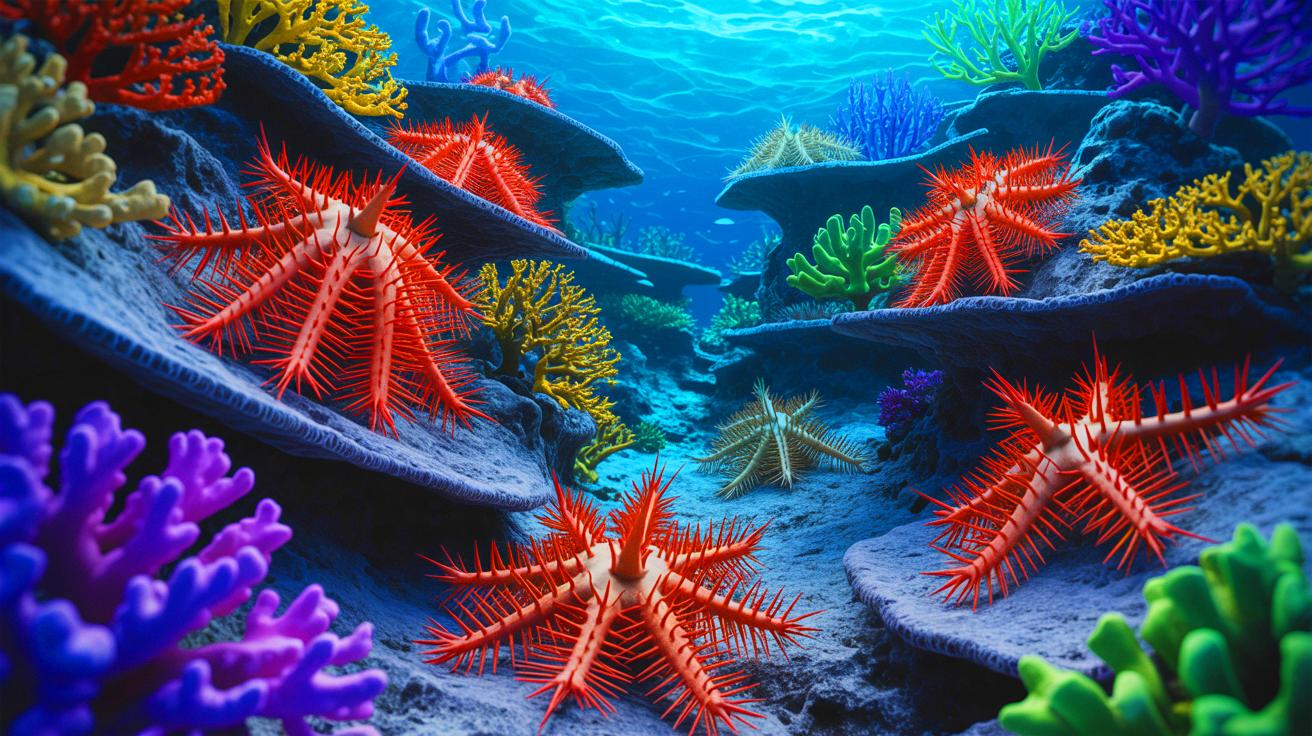- 🌊 Sea stars have existed for over 500 million years, playing crucial roles in marine ecosystems.
- 🔍 Researchers discovered that crown-of-thorns starfish use spines to communicate through chemical signals.
- 🧬 These signals, facilitated by COTSP proteins, allow coordination of movements and behaviors among sea stars.
- 🚀 The development of synthetic peptides, known as Acanthaster attractins, could revolutionize efforts to control sea star outbreaks and protect coral reefs.
Sea stars have long captivated the imagination of marine enthusiasts and scientists alike. Despite being one of the most ancient creatures on Earth, their enigmatic behaviors and ecological roles are still being unraveled. Recent research has illuminated a fascinating aspect of their biology: their ability to communicate and coordinate actions through their spines. This discovery not only sheds light on their mysterious swarming behavior but also opens up new avenues for managing ecological threats posed by certain sea star species.
The Ancient and Mysterious World of Sea Stars
Sea stars have existed for over 500 million years, outlasting even the dinosaurs. These marine creatures, often mistaken for being mere extensions of the ocean floor, are anything but passive. Among the most intriguing is the crown-of-thorns starfish (CoTS), known for its predatory prowess on coral reefs. Despite their simple appearance, sea stars are sophisticated creatures that play crucial roles in their ecosystems.
Research has shown that sea stars, particularly CoTS, are adept at forming large, synchronized groups that can devastate coral reefs. They achieve this through a unique form of chemical communication, utilizing their spiny exteriors to send and receive messages. This ability to communicate is not just a survival tactic but a strategic advantage in the complex web of marine life. The discovery of these communication methods marks a significant step forward in understanding the ecological impact of sea stars.
Unraveling the Secrets of Spine Communication
Scientists from the Australian Institute of Marine Science, Australia’s University of the Sunshine Coast, and the Okinawa Institute of Science and Technology have made groundbreaking discoveries about how CoTS communicate. Their research reveals that these sea stars use their spines to detect and emit chemical signals in the water, akin to a form of mind control. This network of invisible communication allows them to coordinate movements and behaviors without a centralized brain or nervous system.
These signals are facilitated by proteins known as crown-of-thorns starfish-secreted proteins (COTSP). When these proteins are introduced into the water, they can influence the behavior of other sea stars, guiding them in specific directions. This form of communication is not a response to environmental stressors but an active process of social interaction. The implications of this discovery are profound, offering new insights into how sea stars can form large, destructive swarms.
Innovative Strategies for Controlling Sea Star Outbreaks
The destructive potential of CoTS has made them a significant concern for marine conservationists. Traditional methods of controlling their populations have been labor-intensive and largely ineffective. However, the recent discoveries about their communication methods offer new hope. By understanding the chemical messages that guide their movements, scientists have developed synthetic peptides that mimic these signals.
These peptides, known as Acanthaster attractins, can lure CoTS to specific locations, making it easier to manage their populations. This innovative approach could revolutionize efforts to protect coral reefs from these voracious predators. By hijacking the CoTS communication channels, conservationists can potentially prevent the large-scale coral destruction that has plagued many parts of the Pacific Ocean.
The Future of Marine Conservation
The study of sea star communication is not just an academic exercise; it has practical implications for marine conservation. The ability to control CoTS outbreaks through synthetic attractins could be a game-changer in the fight to preserve coral reefs. As researchers continue to explore the genetic and proteomic aspects of these creatures, new strategies for ecological management are likely to emerge.
Professor Noriyuki Satoh, a leading figure in this research, emphasizes the potential of using these discoveries to develop safe and efficient measures against CoTS outbreaks. As we deepen our understanding of these ancient creatures, we are reminded of the intricate balance that sustains marine ecosystems. What other secrets might the ocean hold, and how can we use this knowledge to foster a more sustainable future?
In conclusion, the revelations about sea star communication underscore the complexity and adaptability of marine life. As we continue to study these fascinating creatures, we gain valuable insights into the workings of our planet’s ecosystems. How might these discoveries inspire future conservation efforts, and what other mysteries of the ocean are waiting to be uncovered?
This article is based on verified sources and supported by editorial technologies.
Did you like it? 4.7/5 (25)
